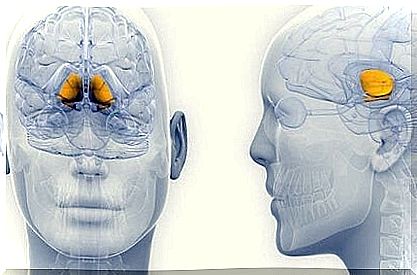Progressive Supranuclear Palsy Or Steele-Richardson-Olszewski Syndrome

Progressive supranuclear palsy is a rare disease. It is a disorder at the brain level that affects the affected person at different levels (motor, cognitive and emotional). Among the various manifestations of this pathology, we can observe movement difficulties, a lack of balance, speech disorders or mood alterations.
Its incidence is generally 3 to 6 per 100,000 people per year. This therefore means that it is one of the least studied neuronal diseases. There is therefore a certain lack of knowledge on this subject. Its symptoms are known, but its aetiology is not yet very defined. In this way, the treatment to be followed is also not extremely specific. Despite this, it is approached in different fields such as medical, psychological or physiotherapeutic.
Progressive supranuclear palsy – what is it?
Authors like Jiménez-Jiménez (2008) define it as a neurodegenerative disease in which there is an accumulation of neurofribillary tangles in neurons and glial cells. This build-up occurs in specific areas of the brainstem and basal ganglia. In this way, there is a gradual decrease in these structures and the loss of their projections to the frontal lobe.
The etiology of this disease is unknown, although some genetic cases are documented. To date, in the absence of further research, it is not known what triggers this disease. Among the best known causes are genetic predisposition and possible environmental factors not yet defined.

Clinical picture
The damage caused by progressive supranuclear palsy affects different levels and causes different disorders. Ardeno, Bembibre and Triviño (2012) discuss some of the consequences of this disease.
- Motor disorders. Gait disturbances, postural instability and parkinsonism stand out.
- Eye disorders. Vertical gaze palsy occurs, especially downwards. We can also note eyelid alterations.
- Cognitive and behavioral disorders. Presence of apathy, depression, social isolation, etc.
- Pseudobulbar syndrome. Spasmodic episodes of laughter and crying, dysphagia, dysarthria, etc. can occur.
Clinical variants
In 1994, Lantos described three types or clinical variants of progressive supranuclear palsy. These variants thus depend on the area in which the neurofibrillary tangles accumulate.
- In the frontal variant, cognitive and behavioral alterations predominate.
- The classic variant is characterized by postural instability, ophthalmoplegia and pseudobulbar syndrome.
- The parkinsonian variant presents an akinetic-rigid framework.
Diagnostic
The diagnosis of this disease can only be confirmed after the post-mortem study. The diagnosis of the living patient is clinical and becomes very complex.
The low incidence of progressive supranuclear palsy makes diagnosis difficult due to limited research and confusion with other types of disease. It is for this reason that a differential diagnosis is usually made for diseases such as Parkinson’s disease, multisystem atrophy, corticobasal degeneration, frontotemporal dementia, or Lewy body dementia.
Diagnostic methods are carried out through different studies using different instruments:
- On the one hand, structural neuroimaging studies are performed by magnetic resonance imaging (MRI).
- Functional neuroimaging studies use single-photon emission tomography (SPECT).
- Finally, positron emission tomography (PET) is also emerging as a tool for detecting this disease.
According to the National Institute of Neurological Disorders and Stroke and the Society for Progressive Supranuclear Palsy , there are different diagnostic criteria for this disease.
Inclusion criteria
Possible progressive supranuclear palsy
- Progressive progressive disease
- Age of onset equal to or less than 40 years
- It can be seen as much in the vertical gaze, in slow vertical jerks or postural instability.
- There is no evidence of other diseases that could explain the above points
Probable progressive supranuclear palsy
- Progressive progressive disease
- Age of onset equal to or less than 40 years
- Vertical gaze palsy
- Postural instability
- There is no evidence of other diseases that could explain the above points
Support criteria
- Akinesia or symmetrical stiffness of the proximal predominance
- Cervical dystonia
- Unresponsive or weak and transient response to levodopa treatment
- Early dysarthria or dysphagia
- Early cognitive impairment with two or more of the following signs: listlessness, decreased fluency, impaired abstract thinking, mimicry of behavior, or signs of frontal slackening
Evaluation
Due to the low presence of this disease in the population, there is no standard and concrete assessment on this subject. For this reason, the assessment is carried out through unique cases, adapting different tests and questionnaires to each patient.
Arnedo, Bembibre and Triviño (2012), through a specific case, present the areas evaluated and the tools used.
- Attention : running test, stroke count, Trail Making Test A , Trail Making Color test .
- Language : Boston vocabulary test, semantics and phonetics, interview and short language protocol.
- Thesis : Digit subtest (WAIS-III), Spatial localization subscale (WMS-III) and King complex figure copy test.
- Executive functions : Matrices subtest (WAIS-III), Similarities subtest (WAIS-III), 5-digit test and Wisconsin card classification test.
- Gnosies : environmental sounds, tactile recognition of objects and test of superimposed figures.
- Visuoperceptive functions : battery of tests of visual perception of objects and space.
- Praxies : King figure copy test, cube subtest (WAIS-III), simple transitive and intransitive gestures, sequence of movements and use of objects.
- Processing Speed : Timed test execution time.
- Psychopathological scales : neuropsychiatric inventory.
- Functional scales : Barthel index and Lawton and Brody scale.

Treatment and conclusion
An effective and specific treatment for progressive supranuclear palsy has not yet been discovered. The only measures applied are palliative, so that the patient maintains an adequate quality of life. In the absence of treatment, the goal is to slow the progression of the disease and to encourage the patient’s autonomy as much as possible.
The treatments usually applied range from visits to various specialists such as neurologists, psychologists, rehabilitators, etc. pharmacological treatments such as levodopa, fluoxetine, amitriptyline or imipramine. On the other hand, with regard to non-pharmacological measures, a main distinction is made between speech therapy, physiotherapy, cognitive stimulation and occupational therapy.
Undoubtedly, research is becoming a fundamental aspect to deepen this disease so little known at the present time. It is indeed only in this way that its cause, evaluation and treatment could be studied more precisely.








